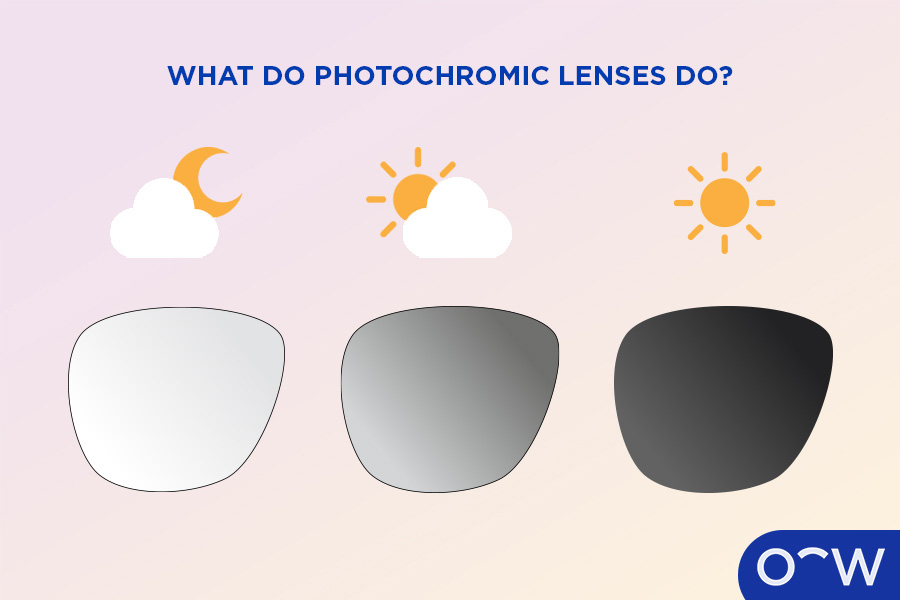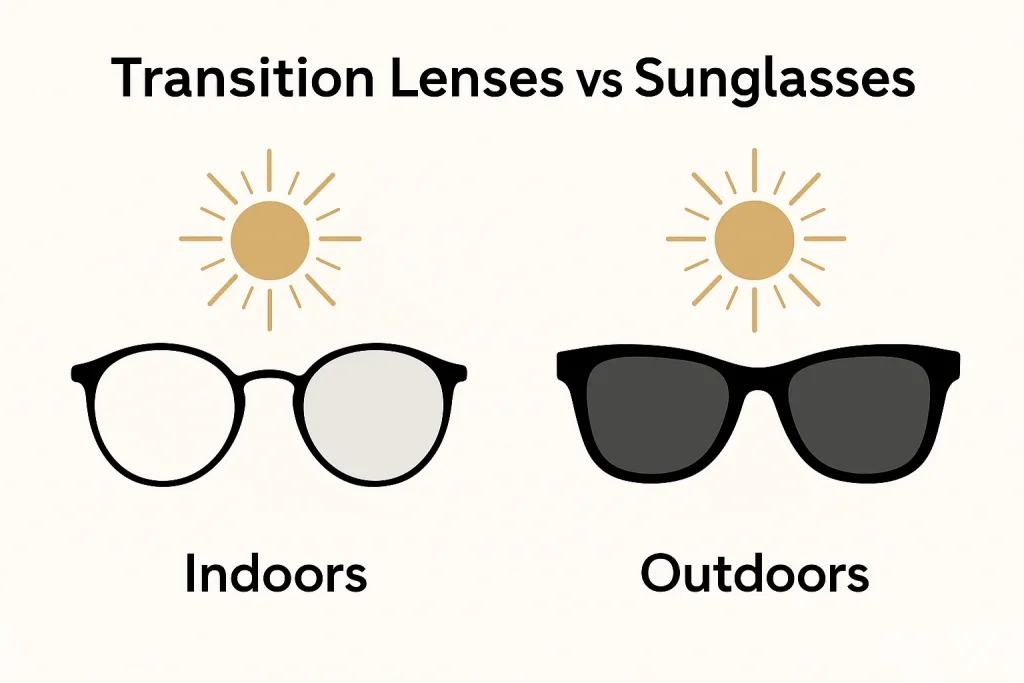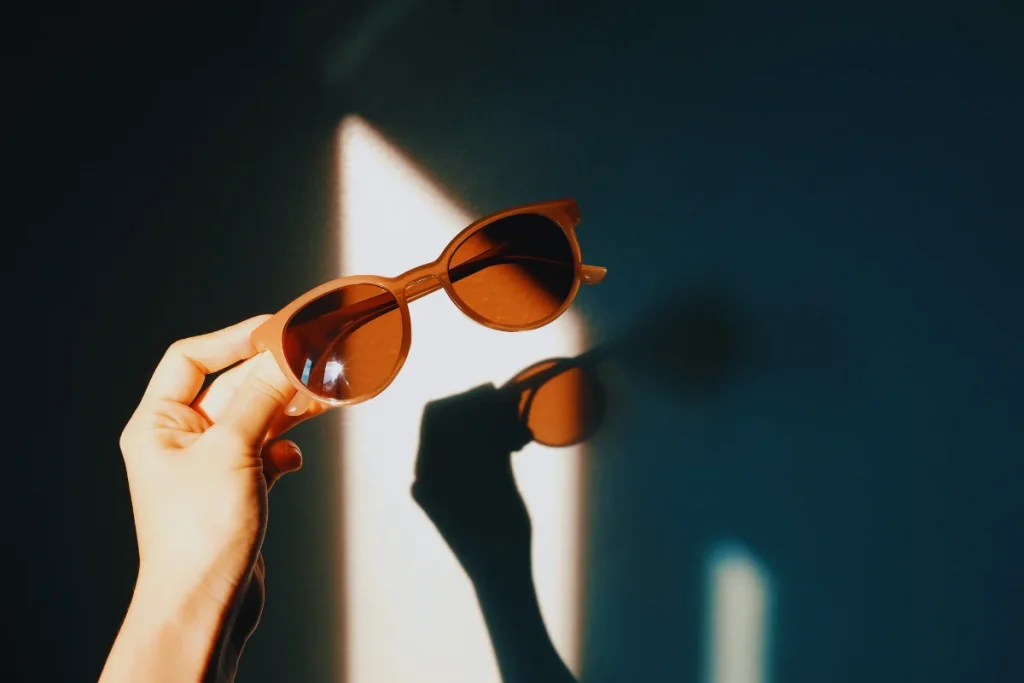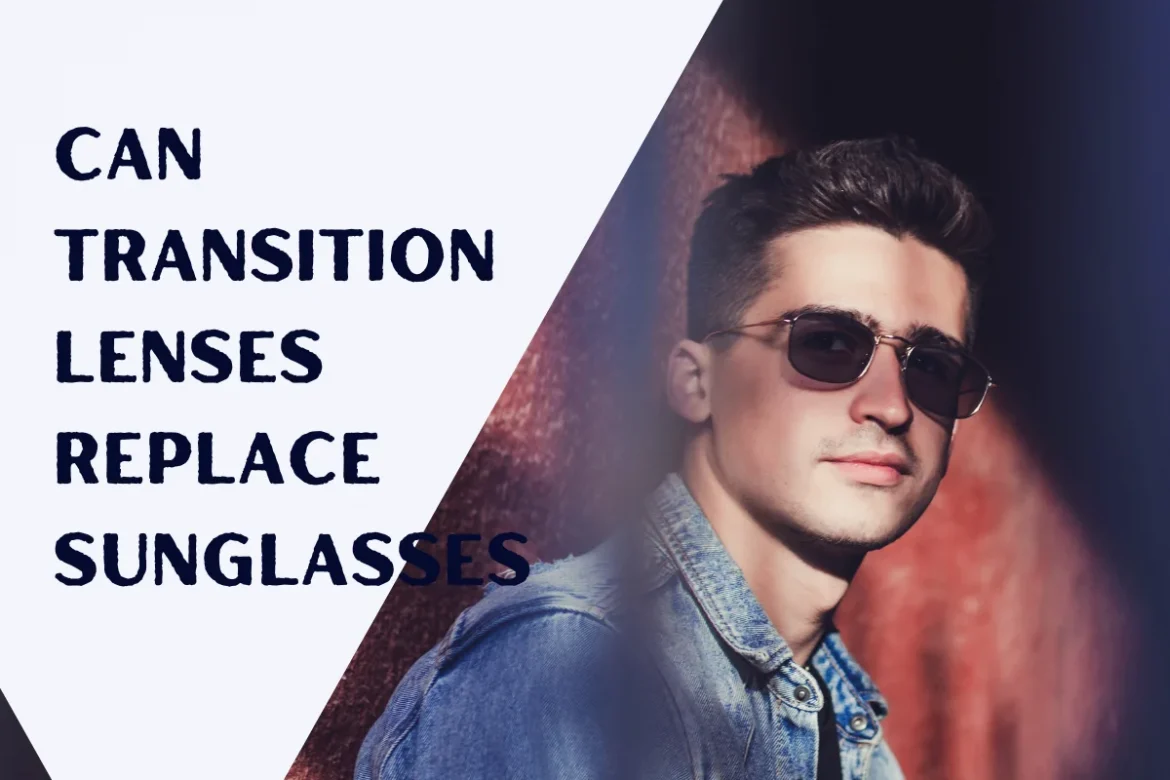Transition lenses, also known as photochromic lenses, are eyeglass lenses that darken in sunlight and return to clear indoors. Designed to respond to ultraviolet (UV) light, they’re a convenient way to protect your eyes from bright conditions without needing separate sunglasses.
Many people consider transition lenses as an all-in-one solution, especially if they wear prescription glasses.
Instead of switching between regular glasses and sunglasses, transition lenses adapt to lighting conditions and reduce the hassle of carrying multiple pairs.
In this blog, we’ll explore if transition lenses can really replace traditional sunglasses. We’ll break down how they work, their pros and cons, and help you decide if they’re the right fit for your lifestyle.
What Are Transition Lenses?
How They Work
Transition lenses have photochromic molecules that respond to ultraviolet (UV) light. When you’re outside in the sun, these molecules activate and the lenses darken. When you step back indoors or into a shaded area, the lenses gradually return to clear.

This happens automatically, no buttons or adjustments needed. The tint intensity depends on the amount of UV exposure, so the lenses will darken more on a bright sunny day and less on a cloudy one.
When They Activate and Return to Clear
Transition lenses start to darken within 30 seconds of sunlight and reach full tint in about 1 to 2 minutes. When you go indoors, they start to lighten almost immediately and usually become fully clear in 2 to 5 minutes.
However, the speed of activation and clearing can vary based on:
- Temperature (they may change slower in very hot or cold weather)
- UV intensity
- Lens material and brand
Why People Like Them
- Convenience: You don’t need to switch between glasses and sunglasses throughout the day.
- UV Protection: They help protect your eyes from UVA and UVB rays.
- Prescription Ready: Transition lenses can be made to match your vision needs, just like regular glasses.
- Seamless Use: Since the change is automatic, they adapt naturally to your environment.
Transition lenses are perfect for people who spend a lot of time moving between indoors and outdoors and want the simplicity of one pair of glasses for all conditions.
Transition Lenses vs Sunglasses
While both transition lenses and sunglasses protect your eyes from bright light and UV rays, they work very differently. Knowing how they compare will help you decide which is right for you.

UV Protection Levels
Both transition lenses and good sunglasses offer strong UV protection. Most transition lenses block 100% of UVA and UVB rays, just like many sunglasses. So both are good at preventing long-term sun damage that can cause cataracts or other eye conditions.
However, not all sunglasses offer full UV protection unless clearly marked. It’s important to check labels to make sure your sunglasses meet safety standards.
Light Response Speed and Adaptability
Transition lenses adapt to changing light automatically. They darken when exposed to UV light and return to clear indoors. However, their speed can vary depending on factors like temperature, lens material, and the strength of sunlight.
Sunglasses, on the other hand, provide instant and consistent darkness when worn. There’s no wait time or transition, you put them on, and they block bright light immediately.
Indoor vs Outdoor Use
Transition lenses are designed to be worn all day, making them perfect for people who move frequently between indoor and outdoor environments. Indoors, they remain clear and look just like regular eyeglasses.
Sunglasses are meant strictly for outdoor use. Indoors, they block too much light and can make your surroundings appear too dim to function comfortably.
Polarization: Most Transition Lenses Are Not Polarized
One key feature sunglasses often have, and most transition lenses lack is polarization. Polarized sunglasses reduce glare from flat, reflective surfaces like water, roads, or snow. This makes them ideal for driving, fishing, skiing, or beach trips.
While some newer transition lenses may offer polarization, many standard versions do not. If you often deal with glare, sunglasses with polarized lenses may still be the better option.
Style Options and Lens Tint Range
Sunglasses offer a wide variety of fashion-forward styles, lens colors, and frame shapes. From mirrored lenses to gradient tints and bold designer frames, the options are nearly endless.
In summary:
| Feature | Transition Lenses | Sunglasses |
| UV Protection | Excellent (built-in) | Excellent (if UV-rated) |
| Response to Light | Adjusts automatically | Instant, fixed tint |
| Indoor Use | Clear and wearable indoors | Not suitable indoors |
| Polarization | Rare or limited | Common in many sunglasses |
| Style Variety | Moderate | Wide range of styles and colors |
When Transition Lenses Can Replace Sunglasses
Transition lenses can be a reliable and practical solution for many daily situations. For people who wear prescription glasses or want a simpler solution for sun protection, these lenses offer flexibility and ease all day.

Good for Daily Outdoor Activities
If your outdoor time includes walking, commuting or just being outside, transition lenses will usually do the trick. They darken in the sun, so you’re comfortable for tasks like running errands, sitting at a sunny café or walking the dog.
You don’t have to remember to switch to sunglasses every time you go outside which is a bonus.
Great for Prescription Glasses Wearers
For those who already need corrective lenses, transition lenses combine vision correction with sun protection. No need to carry two pairs of glasses throughout the day, makes life a little easier and cheaper.
Instead of switching between two pairs all day, you can use one pair for indoor and outdoor.
Easy and Convenient
One of the biggest advantages of transition lenses is simplicity. No need to carry an extra pair of sunglasses or worry about losing them. The lenses respond to changing light automatically, adjust to your surroundings with no extra effort.
This is especially helpful for busy people or those who go in and out of buildings frequently.
Helpful for Light Sensitive Eyes
If you have light-sensitive eyes, transition lenses can reduce discomfort in moderate to strong sunlight. They provide consistent protection when you go outside and adjust quickly to lower light when you go back inside.
This can reduce squinting, eye strain, and sudden visual discomfort from changing light conditions.
Summary: For most day-to-day outdoor activities, transition lenses can be a good substitute for sunglasses. They offer prescription support, UV protection, and automatic adaptability, making them a smart choice for convenience and comfort.
When Transition Lenses May Fall Short
While transition lenses are good for many everyday situations, they do have some limitations. There are times when they may not provide the same level of comfort or protection as regular sunglasses. Know these situations before you rely on them as a full-time substitute.
Slower Response Inside
Transition lenses respond to UV light but most car windshields block UV rays. So the lenses may not darken as much when you’re driving even if it’s very bright outside. So they may not give you the same glare protection as sunglasses especially when driving during sunny afternoons or long road trips.
Not Good for Glare from Water, Snow or Sand
Transition lenses are not polarized so they don’t reduce glare as well as polarized sunglasses. Glare from reflective surfaces like water, snow or white sand can be intense and uncomfortable. For beachgoers, skiers or those near water, sunglasses with polarization are better for visual comfort and safety.
Affected by Extreme Temperatures
Temperature can affect how well transition lenses perform. In very cold weather, they may take longer to clear up once indoors. In hot temperatures, they may not darken as much as expected. This can cause uneven performance, especially when traveling to extreme climates.
Pros and Cons of Transition Lenses
Like any eyewear option, transition lenses have their advantages and disadvantages. Knowing both sides will help you decide if they’re right for your lifestyle and vision needs.
Pros
1. Two-in-One Convenience
Transition lenses combine regular prescription glasses with sun protection in one pair. You don’t have to carry two pairs of glasses or switch between them throughout the day.
2. Seamless Indoor-Outdoor Vision
The lenses adjust to changing light conditions. Indoors, they stay clear. Outdoors, they darken based on sunlight. This is perfect for people who move between different environments frequently.
3. Built-In UV Protection
Most transition lenses block 100% of UVA and UVB rays. This protects your eyes from sun damage, cataracts and other long-term issues.
4. Custom Prescription Options
Transition lenses are available in a wide range of prescription strengths and lens materials. Whether you need single vision, progressive or specialty lenses they can often be customized to your needs.
Cons
1. May Not Darken Behind Windshields
Because car windshields filter out UV light, transition lenses often don’t activate fully while driving. This can reduce their effectiveness in blocking bright light during sunny drives.
2. Limited Fashion or Color Choices
Compared to traditional sunglasses, transition lenses have fewer color tints and style options. Most come in neutral tones like gray or brown which may not suit everyone’s fashion.Not polarized so they don’t reduce glare as well as polarized sunglasses. This can be a problem in high glare areas like beaches, snowy areas or water.
4. Transition Time Varies
The time it takes for lenses to darken or clear up can vary depending on temperature, lens brand and UV exposure. This can cause discomfort during rapid light changes.
Transition Lenses vs Polarized Sunglasses
Transition lenses and polarized sunglasses are both designed to protect your eyes from the sun, but they serve slightly different purposes. If you’re deciding between the two, it helps to know how each works and when one may be more effective than the other.
What Does Polarization Do and Why It Matters?
Polarization is a special filter applied to sunglass lenses that blocks horizontal light waves. These are the same light waves that create glare when sunlight reflects off surfaces like water, roads, snow or car hoods.
Polarized sunglasses reduce that harsh glare, making your vision sharper and more comfortable in bright, reflective environments. This is especially helpful for driving, boating, skiing or spending time at the beach.
Ideal Situations for Each
Transition Lenses Are Best For:
- Daily wear with frequent transitions between indoors and outdoors
- People who need prescription glasses with sun protection
- Light sensitive eyes during regular daylight
- Moderate outdoor exposure like walking, commuting or shopping
Polarized Sunglasses Are Best For:
- Activities with intense glare (driving, fishing, skiing, beach days)
- Long hours in bright sunlight
- Environments with a lot of reflective surfaces
- Eye strain caused by squinting in harsh sunlight
Can Transition Lenses Be Polarized?
Standard transition lenses are not polarized. While they do darken in response to UV light and provide UV protection, they don’t filter glare the same way polarized lenses do.
However, there are newer photochromic lenses available in the market that include polarization. These tend to be more specialized and may not be available in all prescriptions or styles.
When Might You Need Both?
Some people choose to use both transition lenses and polarized sunglasses depending on the situation. For example:
- You might wear your transition lenses every day for work or running errands.
- On weekends or vacations, you might switch to polarized sunglasses for driving, outdoor sports or time at the beach.
Using both options allows you to get the convenience of transition lenses and the glare protection of polarization when you need it most.
Summary: Transition lenses and polarized sunglasses each offer unique benefits. Transition lenses give you indoor-outdoor flexibility with built-in UV protection, while polarized sunglasses excel at reducing glare in high-sun, high-reflection environments. Choose the right one based on how and where you spend your time.
How to Decide
If you’re choosing between transition lenses and polarized sunglasses, think about your daily habits, vision needs, and comfort. The right one often depends on how and where you wear your eyewear.
Your Lifestyle and Daily Activities
If you’re in and out of the house a lot, transition lenses are the way to go. If you’re outside most of the time in strong sunlight, polarized sunglasses may be better for you.
Think About Driving, Sports, Travel, and Screen Use
- Driving: Polarized sunglasses can reduce glare from the road and other cars. Since most car windshields block UV light, transition lenses may not darken fully during driving.
- Sports and Travel: Activities like skiing, fishing, or spending time at the beach often involve a lot of glare. In these cases, polarized lenses are usually more effective.
- Digital Screens: Some polarized lenses can affect visibility on screens like phones, GPS units, or car dashboards. Make sure to test them if you use digital devices often.
Prescription Needs and Budget
If you wear prescription glasses, transition lenses can be a cost effective way to get vision correction and sun protection. But if you prefer darker lenses and glare control, prescription sunglasses are also an option.
Consider your budget and how often you’d use each before deciding.
Try a Combination
You don’t have to choose just one. Many people wear transition lenses for everyday wear and have a pair of polarized sunglasses or clip-on shades for specific activities like driving or beach trips.
This way you can match your eyewear to your needs without complicating your routine.
Final Thoughts
Transition lenses can replace sunglasses in many everyday situations. They’re convenient, offer UV protection and adjust to changing light. For walking, commuting and general outdoor use they’re often enough.
But in bright and reflective environments like driving, snowy landscapes or being out on the water, traditional polarized sunglasses may still perform better.
It all depends on your lifestyle, light sensitivity and how much glare protection you need. Talk to an eye care professional to find the solution that works best for you. They can help you choose based on your prescription, daily habits and comfort.
FAQs
1. Do transition lenses offer full UV protection like sunglasses?
Yes. Most transition (photochromic) lenses block 100% of UVA and UVB rays. This means they offer the same level of UV protection as good sunglasses, reducing the risk of eye conditions like cataracts or macular degeneration.
2. Why don’t transition lenses darken in my car?
Car windshields often filter out UV rays. Since transition lenses work on UV exposure to activate, they may stay mostly clear or lightly tinted while driving, not reaching full darkness.
3. Can transition lenses be polarized?
Yes, but it’s rare. Most standard transition lenses are not polarized. However, advanced options like Transitions® Drivewear or XTRActive Polarized combine photochromic darkening with polarized glare reduction.
4. Are transition lenses dark enough for a beach or snowy landscape?
Not always. While they darken in bright light, they usually don’t reach the darkness of sunglasses. In high-glare situations like beaches or ski slopes, polarized sunglasses are often more effective.
5. How fast do transition lenses change from clear to dark?
Photochromic lenses start to darken in 30 seconds outdoors and fully tint in 1-2 minutes. Fading back indoors takes 2-5 minutes depending on temperature and brand.
6. Are transition lenses good for everyday wear?
Yes—especially if you move between indoors and outdoors or wear prescription glasses. They’re convenient, offer consistent UV protection and reduce the need to carry multiple pairs of eyewear.
7. Do transition lenses cost more than regular sunglasses?
They can be more expensive than regular glasses but when you consider they offer clear and tinted vision in one pair, they often save you money over buying separate prescription glasses and sunglasses.


